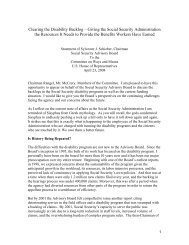Aspects of Disability Decision Making: Data and Materials
Aspects of Disability Decision Making: Data and Materials
Aspects of Disability Decision Making: Data and Materials
You also want an ePaper? Increase the reach of your titles
YUMPU automatically turns print PDFs into web optimized ePapers that Google loves.
Shortly afterwards, SSA published additional regulations (60 FR 47469 (September 13, 1995))that allowed it to test the position <strong>of</strong> “adjudication <strong>of</strong>ficer” in the hearing process, a modificationthat had also been proposed in the 1994 Plan for a New <strong>Disability</strong> Claim Process.1996 The Senior Citizens Right to Work Act <strong>of</strong> 1996 (P.L. 104‐121) eliminated SSI <strong>and</strong> DI benefits for individualsfor whom drug addiction or alcoholism was a “contributing factor material to the determination<strong>of</strong> disability,” <strong>and</strong> required SSA to redetermine the eligibility <strong>of</strong> people already receivingdisability benefits based on a diagnosis <strong>of</strong> drug addiction or alcoholism.The Personal Responsibility <strong>and</strong> Work Opportunity Reconciliation Act (P.L. 104‐193) made severalsignificant changes to the SSI program with respect to disabled children. It:■■made the SSI definition <strong>of</strong> disability for children stricter, requiring that a child have “a medicallydeterminable physical or mental impairment which results in marked <strong>and</strong> severe functionallimitations”■■required SSA to eliminate references to maladaptive behavior from the Listing <strong>of</strong> Impairments;■■required SSA to discontinue individualized functional assessments for children;■■required SSA to conduct CDRs on children who had been allowed based on low birth weightat age 1, <strong>and</strong> to conduct regular CDRs on other children;■■required redeterminations <strong>of</strong> disability at age 18 using the adult disability st<strong>and</strong>ard; <strong>and</strong>■■added several new requirements for representative payees <strong>of</strong> children.As a part <strong>of</strong> its “Process Unification” initiative, SSA issued a series <strong>of</strong> nine Social Security Rulings(61 F.R. 34466 (July 2, 1996)) that addressed a range <strong>of</strong> disability adjudication policies includingthe agency’s policy on the evaluation <strong>of</strong> pain <strong>and</strong> other subjective symptoms, treating sourceopinions, <strong>and</strong> residual functional capacity. SSA conducted agency-wide training for all <strong>of</strong> its15,000 adjudicators <strong>and</strong> quality reviewers on the new rulings. Although process unification hadbeen an important component <strong>of</strong> the 1994 Plan for a New <strong>Disability</strong> Claim Process, its origins werein the 1980s, when class action lawsuits were filed in several States (including Florida, Iowa, Minnesota,Nebraska, Ohio, Oregon, Tennessee, Utah, <strong>and</strong> West Virginia) challenging the st<strong>and</strong>ards<strong>and</strong> practices used by State DDSs in disability claims. Plaintiffs usually claimed that the policiesapplied by the DDS in disability decisions were different <strong>and</strong> stricter than the policies applied atthe hearing level by administrative law judges. “Process Unification” became the umbrella underwhich the agency attempted to respond to the widespread perception that different st<strong>and</strong>ardswere being applied.1997 SSA issued interim final rules (62 FR 6408 (February 11, 1997)), implementing the childhooddisability provisions <strong>of</strong> P.L. 104‐193 (as further modified by the Balanced Budget Act <strong>of</strong> 1997(P.L. 105‐33). These rules revised the disability evaluation process for SSI children by:■■defining the statutory st<strong>and</strong>ard <strong>of</strong> “marked <strong>and</strong> severe functional limitations” in terms <strong>of</strong>“listing-level severity,” (i.e., an impairment that meets, medically equals, or functionally equalsthe severity <strong>of</strong> an impairment in the Listing <strong>of</strong> Impairments);■■deleting references to the former “comparable severity” st<strong>and</strong>ard;■■eliminating the individualized functional assessment; <strong>and</strong>■■removing references to “maladaptive behavior” in the regulations.The rules, with minor revisions, were published as final regulations that became effective in 2001(65 FR 54747 (September 11, 2000)).96 <strong>Aspects</strong> <strong>of</strong> <strong>Disability</strong> <strong>Decision</strong> <strong>Making</strong>: <strong>Data</strong> <strong>and</strong> <strong>Materials</strong>









